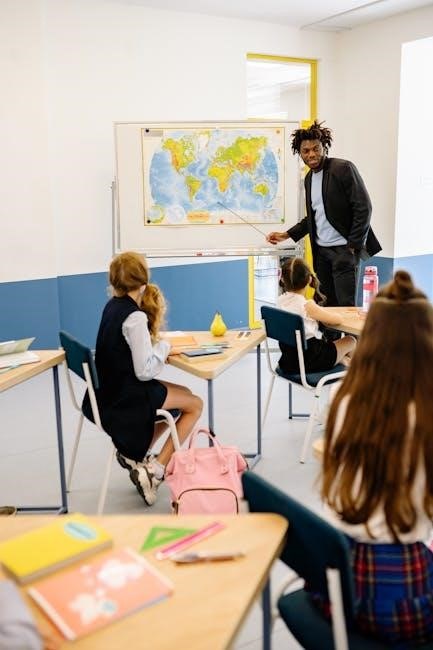Guided writing is an instructional approach where teachers work with small groups of students to improve writing skills through targeted strategies and immediate feedback‚ fostering confidence and independence in learners of all levels.
1.1 Definition and Purpose of Guided Writing
Guided writing is a dynamic‚ small-group instructional strategy where teachers provide targeted support and immediate feedback to enhance students’ writing abilities. It serves as a bridge between shared and independent writing‚ offering scaffolding tools to build confidence and proficiency in composing texts‚ grammar‚ and vocabulary use‚ tailored to students’ specific needs and skill levels.
1.2 The Role of the Teacher in Guided Writing
The teacher plays a pivotal role in guided writing by providing immediate feedback‚ modeling strategies‚ and tailoring instruction to meet specific student needs. They facilitate small-group discussions‚ demonstrate writing techniques‚ and offer scaffolding tools to enhance learning. The teacher’s active involvement ensures students receive targeted support‚ fostering their ability to apply writing skills confidently and effectively in various contexts.
Key Strategies in Guided Writing
Guided writing employs strategies like composing text structures‚ grammar techniques‚ and scaffolding tools to enhance writing skills. It focuses on targeted feedback and immediate guidance to improve accuracy and fluency in student writing across various levels and genres.
2.1 Composing and Text Structure Strategies
Guided writing emphasizes teaching students to plan‚ draft‚ and organize their ideas effectively. Teachers use graphic organizers and writing frames to help structure texts‚ ensuring clarity and coherence. Students learn to use transitions‚ topic sentences‚ and supporting details to create well-organized paragraphs. These strategies are tailored to students’ skill levels‚ fostering their ability to compose clear and structured written content.
2.2 Grammar‚ Spelling‚ and Punctuation Techniques
Guided writing focuses on improving grammar‚ spelling‚ and punctuation by targeting specific skills. Teachers use cue cards‚ sentence frames‚ and immediate feedback to correct errors. Students practice constructing grammatically correct sentences and applying proper punctuation. This approach ensures learners develop accuracy and clarity in their writing‚ building a strong foundation for effective communication.

The Four-Step Process of Guided Writing
Guided writing follows a structured process: shared experiences‚ discussing strategies‚ guided writing time‚ and sharing work with feedback‚ fostering improvement and confidence in learners.
3.1 Shared Experience and Discussion
Guided writing begins with a brief shared experience‚ such as reading or discussing a topic‚ to engage students and generate ideas. Teachers then lead a discussion to brainstorm ideas‚ clarify concepts‚ and introduce writing strategies. This interactive step ensures students are focused and prepared‚ laying a strong foundation for the writing process.
3.2 Discussing Strategic Behavior for Writing
Teachers discuss strategic behaviors‚ such as brainstorming‚ outlining‚ or using sentence frames‚ to guide students in organizing their thoughts. This step involves modeling writing techniques‚ explaining key strategies‚ and encouraging students to think critically about their writing. It helps students connect their ideas logically and prepares them for the writing phase with clear direction and purpose.
3.3 Writing Time with Immediate Teacher Guidance
During this phase‚ students write independently while the teacher circulates to provide individualized support. The teacher offers feedback on grammar‚ vocabulary‚ and sentence structure‚ ensuring students apply the discussed strategies. This immediate guidance helps students stay on track‚ address challenges‚ and improve their writing skills in real-time‚ fostering confidence and clarity in their work.
3.4 Sharing and Feedback
After writing‚ students share their work‚ receiving constructive feedback from peers and the teacher. This collaborative process reinforces writing strategies and builds confidence. The teacher provides specific‚ actionable insights‚ helping students refine their skills and understand how to improve. Sharing fosters a supportive environment where learners gain new perspectives and celebrate progress‚ enhancing their writing abilities through shared experiences and guided reflection.

Research Supporting Guided Writing
Studies demonstrate the effectiveness of guided writing in enhancing students’ writing abilities. Research by Dieni (2022) highlights significant improvements in sentence construction and vocabulary use‚ validating its structured approach.
4.1 Studies Showcasing Improved Writing Skills
Empirical evidence highlights the effectiveness of guided writing in improving students’ writing skills. Studies‚ such as Dieni’s (2022)‚ demonstrate advancements in sentence structure‚ vocabulary use‚ and grammar. These enhancements contribute to better overall writing quality and foster confidence‚ enabling students to write more independently.
4.2 Effectiveness in Sentence Construction and Vocabulary Use
Guided writing enhances sentence construction by teaching students to craft grammatically correct and structurally complex sentences. It also expands vocabulary use through targeted instruction and scaffolded practices. Strategies like modeling‚ sentence frames‚ and peer discussion help learners apply new words and sophisticated sentence structures effectively‚ leading to more coherent and expressive writing outcomes across various writing tasks.
Guided Writing vs. Shared and Independent Writing
Guided writing serves as a bridge between shared and independent writing‚ providing scaffolding tools to support students’ transition to more autonomous writing experiences.
5.1 The Bridge Between Shared and Independent Writing
Guided writing acts as a transitional phase‚ bridging shared and independent writing by providing scaffolding tools. It builds on shared experiences while offering support‚ enabling students to gradually take ownership of their writing process and prepare for more autonomous tasks.
5.2 Scaffolding Tools for Student Support
Scaffolding tools like graphic organizers‚ sentence frames‚ and cue cards provide structured support‚ helping students organize ideas and use language effectively. These resources guide learners in constructing coherent texts‚ fostering independence and confidence in their writing abilities over time.
Scaffolding Techniques in Guided Writing
Scaffolding techniques provide temporary support to students‚ such as graphic organizers and sentence frames‚ helping them structure ideas and use language effectively while developing writing independence.
6.1 Graphic Organizers and Writing Frames
Graphic organizers and writing frames are essential scaffolding tools in guided writing‚ helping students visually structure ideas and use appropriate language. These tools enhance idea generation‚ coherence‚ and vocabulary use‚ while supporting grammar and sentence construction. They are particularly beneficial for ESL learners and struggling writers‚ providing clear frameworks to guide the writing process and foster independence.
6.2 Cue Cards and Sentence Frames
Cue cards and sentence frames provide students with visual and structural support‚ helping them initiate and organize writing. These tools offer sentence starters‚ vocabulary prompts‚ and grammar guides‚ enabling learners to focus on content while developing language skills. They are particularly effective for students struggling with sentence construction‚ fostering confidence and clarity in their writing endeavors‚ especially during guided writing sessions.
Implementing Guided Writing in the Classroom
Implementing guided writing involves selecting targeted goals‚ using scaffolding tools‚ and grouping students by ability to provide tailored support. This structured approach ensures effective skill development and engagement.
7.1 Selecting Targeted Writing Goals
Selecting targeted writing goals involves identifying specific skills students need to develop‚ such as grammar‚ vocabulary‚ or sentence structure. Teachers align these goals with curriculum standards and student needs‚ ensuring clarity and focus. This step ensures that instruction is purposeful and tailored‚ allowing students to progress systematically in their writing abilities over time.
7.2 Grouping Students by Similar Abilities
Grouping students by similar abilities allows teachers to provide personalized instruction tailored to specific writing needs. This approach ensures that each student receives targeted support‚ fostering a collaborative learning environment. By addressing shared skill levels‚ teachers can implement strategies that cater to the group’s strengths and challenges‚ helping students progress at an appropriate pace and build confidence in their writing abilities.

Assessing Student Progress in Guided Writing
Assessment involves observing student writing‚ providing immediate feedback‚ and using marking criteria to evaluate progress. This helps identify strengths‚ areas for improvement‚ and track growth over time.
8.1 Providing Immediate Feedback
In guided writing‚ immediate feedback is crucial for student growth. Teachers provide specific‚ timely comments during the writing process‚ helping students revise and refine their work. This direct interaction clarifies doubts‚ addresses errors‚ and reinforces positive writing strategies‚ fostering improvement and confidence. Feedback is tailored to individual needs‚ ensuring students understand how to enhance their writing effectively.
8.2 Using Marking Criteria for Evaluation
Marking criteria provide a structured approach to evaluating student progress in guided writing. Teachers use predefined standards to assess writing quality‚ ensuring consistency and clarity. Criteria often include elements like content‚ structure‚ grammar‚ and vocabulary. Detailed feedback based on these criteria helps students identify strengths and areas for improvement‚ guiding their growth and refining their writing skills effectively over time.

Real-Life Examples and Case Studies
Guided writing has been successfully implemented in various classrooms‚ showcasing improved writing skills and sentence construction. Case studies highlight student progress and the effectiveness of targeted strategies in real learning environments.
9.1 Successful Guided Writing Lessons in Action
Guided writing lessons have proven effective in classrooms‚ demonstrating significant improvements in students’ writing abilities. For example‚ one lesson focused on using graphic organizers to structure essays‚ resulting in clearer arguments and better organization. Another involved peer feedback sessions‚ which enhanced students’ ability to revise and refine their work independently. These practical examples highlight the transformative impact of guided writing strategies.
9.2 Student Improvement Stories
Students who participated in guided writing sessions showed remarkable progress in their writing skills. One student struggled with sentence structure but‚ after targeted lessons on grammar and vocabulary‚ produced coherent‚ detailed paragraphs; Another improved their ability to organize ideas using graphic organizers. These stories highlight how guided writing fosters confidence and fluency‚ empowering students to become capable writers.
The Future of Guided Writing
Guided writing’s future lies in integrating technology‚ such as digital tools for real-time feedback and adaptive strategies‚ ensuring personalized support for diverse learners in evolving educational landscapes.
10.1 Integrating Technology into Guided Writing
Integrating technology into guided writing enhances learning through digital tools like real-time feedback software‚ interactive platforms‚ and customizable writing apps; These tools provide scaffolded support‚ enabling students to practice writing independently while receiving immediate guidance. Technology also offers diverse resources‚ such as grammar checkers and vocabulary builders‚ to cater to varying learner needs‚ fostering engagement and progress in the writing process.
10.2 Adapting Strategies for Diverse Learners
Guided writing strategies can be tailored to meet the needs of diverse learners by incorporating scaffolding tools‚ such as graphic organizers and sentence frames‚ to support varying abilities. Teachers can differentiate instruction by targeting specific skills‚ like grammar or vocabulary‚ and providing individualized feedback. This approach ensures all students‚ regardless of their learning level‚ can engage effectively and make progress in their writing development.
Guided writing empowers students by bridging skill gaps and fostering independence‚ making it an invaluable approach for educators to nurture future writers effectively.
11.1 Summarizing the Benefits of Guided Writing
Guided writing empowers students by enhancing their writing skills‚ fostering independence‚ and bridging skill gaps. It builds confidence‚ improves grammar‚ vocabulary‚ and sentence structure through scaffolding and immediate feedback‚ making it an invaluable approach for educators to nurture capable and confident writers across all ability levels.
11.2 Encouraging Teachers to Adopt Guided Writing Practices
Teachers are encouraged to embrace guided writing as it offers tailored support‚ fostering student confidence and skill development. Its adaptability to diverse learners and proven effectiveness in enhancing writing outcomes make it a valuable tool. By integrating guided writing‚ educators can create a nurturing environment that empowers students to grow into capable and creative writers.
